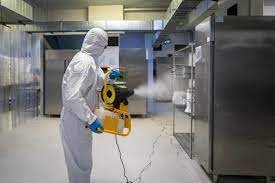Exploring the Role of Disinfectant Foggers in Maintaining Hygiene and Preventing Illness
In today's world, where cleanliness and hygiene have taken center stage, the demand for effective disinfection solutions has soared. Among these, disinfectant foggers have emerged as a popular choice for maintaining hygiene and preventing the spread of illness. But what exactly are disinfectant foggers, and how do they contribute to these objectives? Let's embark on a journey to explore their role in maintaining hygiene and preventing illness.
Understanding Disinfectant Foggers
Disinfectant foggers, also known as fogging machines or misters, are devices designed to disperse disinfectant solutions in the form of a fine mist or fog. These machines utilize pressurized air or electricity to create a fog of disinfectant particles that can reach inaccessible areas and cover surfaces more effectively than traditional cleaning methods.
How Do Disinfectant Foggers Work?
Disinfectant foggers work by converting liquid disinfectant solutions into tiny droplets or particles, which are then dispersed into the air or onto surfaces using a nozzle or sprayer. The fog produced by these machines can penetrate cracks, crevices, and other hard-to-reach areas, ensuring thorough coverage and effective disinfection.
The Role of Disinfectant Foggers in Maintaining Hygiene
Disinfectant foggers play a crucial role in maintaining hygiene in various settings, including:
- Commercial Spaces
In commercial settings such as offices, restaurants, hotels, and retail stores, where high foot traffic and shared spaces increase the risk of germ transmission, disinfectant foggers provide a quick and efficient way to sanitize surfaces and reduce the spread of illness among employees and customers. - Healthcare Facilities
In hospitals, clinics, and other healthcare facilities, where infection control is paramount, disinfectant foggers are used to disinfect patient rooms, waiting areas, surgical suites, and medical equipment, helping to prevent the spread of healthcare-associated infections (HAIs) and safeguard patient health. - Educational Institutions
In schools, colleges, and universities, where large numbers of students and staff congregate daily, disinfectant foggers are employed to sanitize classrooms, laboratories, libraries, and other common areas, minimizing the risk of outbreaks and ensuring a safe learning environment for students and educators. - Public Transportation
In mass transit systems such as buses, trains, airplanes, and subway systems, where passengers come into close contact with shared surfaces, disinfectant foggers are used to sanitize vehicles and stations, reducing the risk of germ transmission and enhancing passenger safety.
Preventing Illness Through Effective Disinfection
Effective disinfection plays a vital role in preventing the spread of illness, including: - Viral Infections
Disinfectant foggers are effective in combating viral infections such as influenza, norovirus, and COVID-19 by killing pathogens on surfaces and in the air, reducing the likelihood of transmission from contaminated surfaces or respiratory droplets. - Bacterial Infections
Disinfectant foggers help prevent bacterial infections by eliminating harmful bacteria such as Staphylococcus aureus, Escherichia coli, and Salmonella typhimurium from surfaces, reducing the risk of foodborne illnesses, skin infections, and other bacterial-related diseases. - Fungal Infections
Disinfectant foggers are also effective against fungal infections such as mold and mildew, which can thrive in damp, humid environments. By eliminating fungal spores and preventing their growth, fogging machines help maintain indoor air quality and prevent respiratory issues associated with mold exposure.
Conclusion
In conclusion, disinfectant foggers play a crucial role in maintaining hygiene and preventing illness in various settings, from commercial spaces and healthcare facilities to educational institutions and public transportation. By effectively dispersing disinfectant solutions as a fine mist or fog, these machines ensure thorough coverage of surfaces and inaccessible areas, reducing the risk of germ transmission and promoting a safer, healthier environment for all. As we continue to navigate the challenges posed by infectious diseases, disinfectant foggers remain indispensable tools in our arsenal against illness and infection.
FAQs (Frequently Asked Questions) - Are disinfectant foggers safe to use in all environments?
Disinfectant foggers are generally safe to use in most environments when used according to manufacturer instructions and safety guidelines. However, precautions should be taken to avoid inhalation of disinfectant fumes, and appropriate protective gear should be worn when operating fogging machines in enclosed spaces. - How often should disinfectant fogging be performed to maintain hygiene?
The frequency of disinfectant fogging depends on factors such as the level of foot traffic, the risk of germ transmission, and the specific requirements of the environment. In high-traffic areas or settings with heightened infection risk, fogging may be performed more frequently, while in low-risk environments, periodic fogging may suffice. - Can disinfectant foggers effectively eliminate airborne pathogens?
Disinfectant foggers can help reduce the concentration of airborne pathogens by dispersing disinfectant particles into the air. However, airborne transmission of certain pathogens may still occur, and additional measures such as ventilation and air filtration may be necessary to minimize the risk of infection. - Can disinfectant foggers replace traditional cleaning methods?
Disinfectant foggers should be used as a supplementary measure to complement traditional cleaning methods such as wiping and scrubbing surfaces. While fogging machines provide thorough coverage and reach inaccessible areas, manual cleaning is still necessary to remove visible dirt, debris, and organic matter before disinfection. - Are all disinfectant solutions suitable for use in fogging machines?
Not all disinfectant solutions are compatible with fogging machines. It's essential to use disinfectants specifically formulated for fogging, as these solutions are designed to create a fine mist or fog that can be effectively dispersed by the machine. Using the wrong disinfectant may result in ineffective fogging or damage to the equipment.
